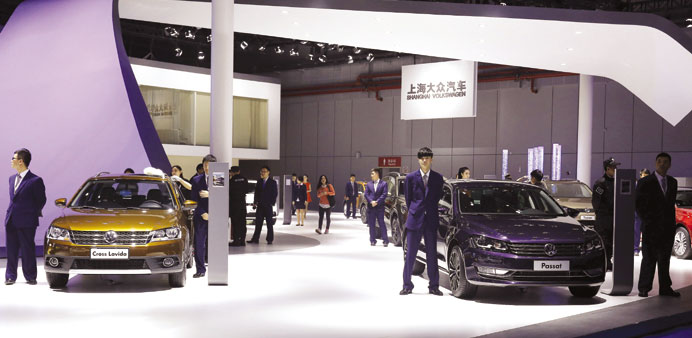Volkswagen cars are seen during 16th Shanghai International Automobile Industry Exhibition. Premium brands in China on average have higher financing penetration of around 50%, a top official said, while about 40% of VW Group buyers finance their purchases.
Reuters/Beijing
When China’s central bank singled out auto financing companies for extra help on Tuesday, it effectively freed up more than 200mn yuan ($30mn) for Volkswagen AG’s China finance unit, which it can use to boost falling car sales, a top official said yesterday.
Along with a cut in benchmark lending rates, the People’s Bank of China cut the amount of reserves financial institutions need to hold by half a percentage point, but topped that up to 3.5 percentage points for auto financing.
“It can be used to reduce our cost of funds, and we can pass that on to the customers,” General Manager Harald Mueller told Reuters.
Volkswagen Finance (China) Co Ltd is discussing with VW Group’s various brands, which include Audi and Porsche, how to spend the funds freed up by the lower reserve requirement ratio (RRR) to relieve the points of highest pressure, he said.
That could include lowering interest rates for certain models or segments, lending to dealers or investing in the finance company’s own operations, he said.
As China’s economic growth in 2015 heads for a 25-year low, Volkswagen Group’s China sales fell 5.3% year-on-year for the January-to-July period, trailing the overall market’s 0.4% growth.
The world’s largest auto market is only expected to improve slightly towards the end of the year, with the China Association of Automobile Manufacturers (CAAM) having cut its 2015 forecast for sales growth to 3% from 7% in July.
“(The RRR cut) will not be a big boost, but it’s more than symbolic,” Mueller said. “It shows that the PBoC is seriously looking into every area.”
The cash freed up is equivalent to about 0.5% of the company’s outstanding loans, he said.
Auto financing companies already enjoyed lower reserve requirements than big banks. After this week’s cut, auto financing companies must hold 8% reserves compared with 18% for banks in general.
Financing helps sales by enabling customers to buy cars they aspire to, not just the ones they can afford now, or lets them to spend on additional features, Mueller said.
The cut to RRR will benefit some auto companies more than others, as buyers of local and mass-market brands are less likely to use financing. “Most Chinese people buy cars with cash. There are few people who use loans,” said an official at a mass-market Japanese automaker. “As of now, (the cut) won’t act as a shot in the arm for demand.”
In China 22.6% of buyers used auto-financing in the first-half of 2015, up from 19.6% a year earlier, according to analysts at Bernstein.
Premium brands in China on average have higher financing penetration of around 50%, Mueller said, while about 40% of VW Group buyers finance their purchases.
A spokeswoman for General Motors Co’s financial subsidiary, which has a Chinese finance joint venture with local maker SAIC Motor Corp, said the company was still assessing the impact of the RRR cut and it was too early to discuss.
Mercedes maker Daimler AG and BMW AG both said they appreciated the central bank’s cut and that it would boost the industry.



